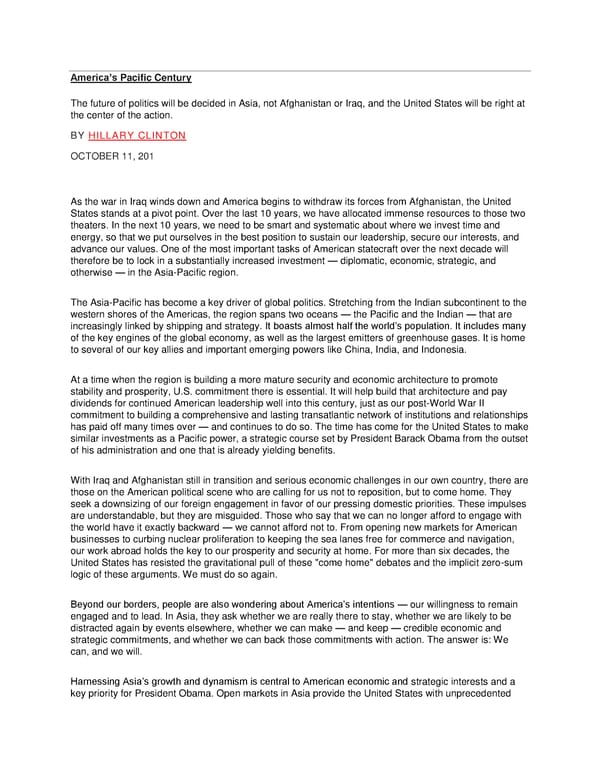HRC America's Pacific Century
America’s Pacific Century The future of politics will be decided in Asia, not Afghanistan or Iraq, and the United States will be right at the center of the action. BY H I L L A R Y C L I N T O N OCTOBER 11, 201 As the war in Iraq winds down and America begins to withdraw its forces from Afghanistan, the United States stands at a pivot point. Over the last 10 years, we have allocated immense resources to those two theaters. In the next 10 years, we need to be smart and systematic about where we invest time and energy, so that we put ourselves in the best position to sustain our leadership, secure our interests, and advance our values. One of the most important tasks of American statecraft over the next decade will therefore be to lock in a substantially increased investment — diplomatic, economic, strategic, and otherwise — in the Asia-Pacific region. The Asia-Pacific has become a key driver of global politics. Stretching from the Indian subcontinent to the western shores of the Americas, the region spans two oceans — the Pacific and the Indian — that are increasingly linked by shipping and strategy. It boasts almost half the world’s population. It includes many of the key engines of the global economy, as well as the largest emitters of greenhouse gases. It is home to several of our key allies and important emerging powers like China, India, and Indonesia. At a time when the region is building a more mature security and economic architecture to promote stability and prosperity, U.S. commitment there is essential. It will help build that architecture and pay dividends for continued American leadership well into this century, just as our post-World War II commitment to building a comprehensive and lasting transatlantic network of institutions and relationships has paid off many times over — and continues to do so. The time has come for the United States to make similar investments as a Pacific power, a strategic course set by President Barack Obama from the outset of his administration and one that is already yielding benefits. With Iraq and Afghanistan still in transition and serious economic challenges in our own country, there are those on the American political scene who are calling for us not to reposition, but to come home. They seek a downsizing of our foreign engagement in favor of our pressing domestic priorities. These impulses are understandable, but they are misguided. Those who say that we can no longer afford to engage with the world have it exactly backward — we cannot afford not to. From opening new markets for American businesses to curbing nuclear proliferation to keeping the sea lanes free for commerce and navigation, our work abroad holds the key to our prosperity and security at home. For more than six decades, the United States has resisted the gravitational pull of these "come home" debates and the implicit zero-sum logic of these arguments. We must do so again. Beyond our borders, people are also wondering about America’s intentions — our willingness to remain engaged and to lead. In Asia, they ask whether we are really there to stay, whether we are likely to be distracted again by events elsewhere, whether we can make — and keep — credible economic and strategic commitments, and whether we can back those commitments with action. The answer is: We can, and we will. Harnessing Asia’s growth and dynamism is central to American economic and strategic interests and a key priority for President Obama. Open markets in Asia provide the United States with unprecedented
 HRC America's Pacific Century Page 2
HRC America's Pacific Century Page 2